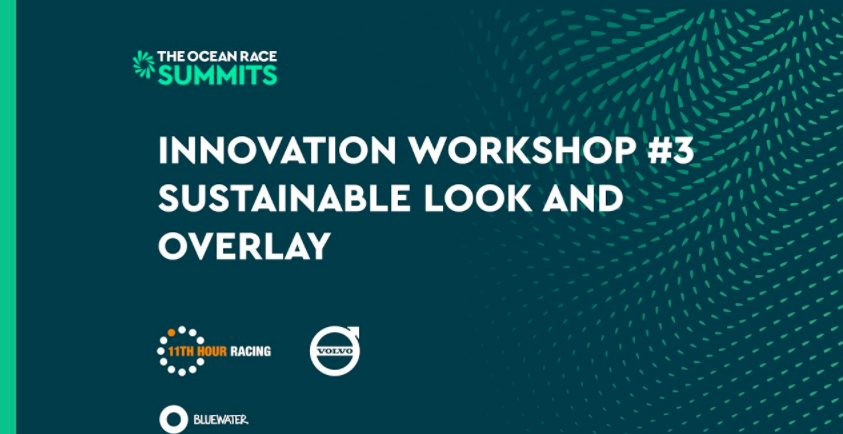
- This event has passed.
The Ocean Race Summit – Innovation Workshop

INNOVATION WORKSHOP
Sustainable Look and Overlay for Events
Industry collaboration and workshop
Tuesday May 26, 2.30pm to 5.30pm CEST
Watch live: https://www.youtube.com/watch?v=naBUJQuCLaQ
________________________________________________________
Collectively we can make a huge impact by supporting innovation and new materials, committing to new systems and processes, ensuring 100% materials capture and circularity, engaging the entire value chain, and importantly to re-examine our need for branding that is designed for a short life and a one-way journey.
We have had an outstanding response and needed to limit it to 120 participants! So for everyone else that has a keen interest in the topic, we have created a super team and will stream live for you to watch. They have all agreed to be ‘on show’ and are happy that there will be viewers watching them co-create for industry leadership.
The topics being covered across all the various workshop teams are included at the bottom of this email if you are interested to read more!
It’s going to be quite raw as it will be like peeping in on an active workshop with post-it notes on our virtual whiteboard, so do moderate your expectations! This is not a training webinar on the topic…. but insightful for the sustainable look and overlay nerds out there to watch the experts co-create a pathway to excellence!
TEAM 1: INDUSTRY LEADERSHIP: SYSTEMS AND INNOVATION – PUBLIC STREAM
Considering our overarching goals of reduction, circularity and innovation, this group of diverse industry representatives will look at the entire value chain and uncover the opportunities for leadership at every step, collaboration being the underlying premise! Will everything come back to leadership from event owners, demand from stakeholders and regulation?
TEAM 2: MATERIALS RECOVERY AND CIRCULARITY
There’s no such thing as waste. This team will focus on how to optimise recovery of single-use resources from event sites and ensure they make their way back into the circular economy. Connecting the links between materials choices and recovery possibilities will be key. Collaboration across the entire value chain is essential to have thorough Materials Stewardship – but who will take the leading role?
TEAM 3: REDUCTION AND EFFICIENCY
Working within the parameters of our earth’s resources is fundamental to sustainability and ensuring sustainable development. A key foundation is to be responsible and efficient with the resources that are used. This team will look at efficiency at every step from manufacturing, through design, production and installation. They will also consider how innovation and collaboration can drive new ways to design-in efficiency. Are there ways to get our messages and ‘look’ across, having the same impact and outcomes, while using less?
TEAM 4: THE DESIGN IMPERATIVE
Can we design our way out of this? Designers are pivotal at so many stages, but often one designer is not connected with the next. How can the event designer, brand creator, site designer, graphic designer, scenic designer and others, work with the more practical players in the value chain such as manufacturers, producers, operations managers, site teams and recyclers, to optimise efficiency, innovative solutions and circularity?
TEAM 5: SOLVING SILOISM
Every event comes together because of a massive team of people playing their part in harmony. We have all experienced that dance. If it works or not, will often depend if we are working well as a team. This team (!) will look for the cracks along the value chain that tempt us to work in silos. Without each player knowing the consequences of their move on the next, we can’t anticipate a win. How can we avoid silosim?
TEAM 6: IGNITING INNOVATION
Necessity is the mother of invention. Right now we have the perfect combination of factors that should spark innovation at every turn. We have an urgent environmental crisis. We have time on our hands to reimagine and invent. And we have an industry that must re-start lean. What can we do right now to inspire innovation all along the value chain? How can we resource the change that is needed?
TEAM 7: MOVING GOALPOSTS
Diverse destinations, short timelines, changing briefs, last-minute decisions. The temporary nature of events can be the antithesis of efficient resource use. How do we remain agile, responsive, creative and dynamic, meet deadlines and delivery, whilst also being sustainable? With so many variables, lack of solutions in all markets, inconsistencies of approach and a variety of ‘best practice’ options, which way should we turn? Indoors or out. Multi-day, many months or a few hours. Sun, snow, rain, wind and water. So many factors to consider!
TEAM 8: THE SCIENCE OF ACTION
We know we need to stand behind the science, but how do we do that? How can we make sure that science informs our decision-making? The full life cycle assessment of materials is one thing, but with the huge variety of applications, what can we really draw on to make good decisions? At what point do we apply the precautionary principle? Or do we go with the mantra of 70% of the information is good enough if you’re on your toes to course correct.
Can waiting for 90% of the information paralyse us from action?

